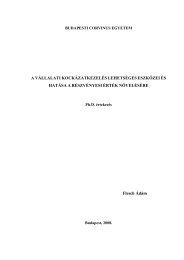Klára Pásztor-Huszár - Budapesti Corvinus Egyetem
Klára Pásztor-Huszár - Budapesti Corvinus Egyetem
Klára Pásztor-Huszár - Budapesti Corvinus Egyetem
You also want an ePaper? Increase the reach of your titles
YUMPU automatically turns print PDFs into web optimized ePapers that Google loves.
eduction was obtained at higher pressures. The other protein fractions didn’t show<br />
immunochemical reactions, most likely because the human serum originated from a patient<br />
who was sensitive only to casein.<br />
Decrease in immunoreactivity could be noticed only in skim milk but not in whole milk<br />
under the applied conditions of the experiment.<br />
HP seemed to decrease the immunoreactivity of certain protein fractions in the different<br />
milk types. According to the separation and immunoblotting methods used, the extent of the<br />
decrease was not significant, except for mare’s milk. Thus HP treatment alone did not prove<br />
to be useful to produce hypoallergenic milk or milk products.<br />
Heat treated and pressurized bovine milk, bovine whey and goat milk samples were<br />
included in the fluorescence investigations. Intensities of tryptophan emission, retinol<br />
emission and excitation were measured and compared.<br />
Irrespective of the material investigated and the type of spectra (emission or excitation),<br />
the overall tendency was in each case was that the fluorescence intensity increased with<br />
higher temperature of the treatment and decreased with increasing pressure.<br />
In the Trp emission measurements, bovine whey showed the lowest intensity values<br />
followed by whole bovine milk. Whole goat milk had the highest intensity values. These<br />
differences resulted from the composition of the milk types and whey. Whey contains only<br />
whey proteins. Casein, the highest protein fraction in milk, can not be found in it. Goat milk<br />
contains more protein than bovine milk. The maximum of the emission spectrum of control<br />
whey was located at 334 nm and of the 100°C/30 mins sample at 341,7 nm, thus a marked red<br />
shift could be observed. More pronounced changes took place in the Trp emission in bovine<br />
milk than in whey. The emission peak in raw bovine milk was found at 342 nm. Goat milk<br />
had the highest intensity values and this type of milk reacted to heat and to pressure the most,<br />
because its emission intensity changed in a slightly higher degree, than that of bovine milk.<br />
About 1 nm red shift could be noticed in goat milk samples as an effect of heat treatment.<br />
Whole bovine milk samples were stored overnight at refrigerator temperature. Intensity of<br />
emission spectra of samples measured directly after the treatments were compared to the<br />
intensity values of stored samples. Trp emission intensity of stored samples was lower than<br />
the intensity of “fresh” samples. Not only the intensity, but also the intervals between the<br />
spectral curves of stored samples were smaller. This indicated that structural re-arrangement,<br />
primarily partial refolding of milk proteins, first of all β-Lg, took place during storage, and it<br />
was equivalent to conformational changes caused by an approx. 20°C drop in temperature.<br />
8
















